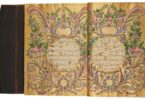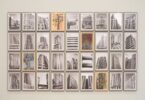Razmig Bedirian
Two paintings by Ayman Baalbaki have been removed from a coming Christie’s sale after a series of complaints about the works.
The withdrawn pieces include Al Moulatham, a 2012 painting that depicts a man whose face is covered in a bright red keffiyeh. It is part of a series by the Lebanese painter. The painting had an estimated sale price of $98,000 to $150,000.
Anonymous, meanwhile, was created between 2011 and 2018. It is a portrait of a man in a gas mask with a red band around his head bearing the word “thaeroun” in Arabic, which can translate as “rebels”. The painting had an estimated sale price of $15,000 to $22,000.
The auction, scheduled to take place on Thursday in London, is part of a biannual sale of modern and contemporary Middle Eastern art by Christie’s.
:quality(70)/cloudfront-eu-central-1.images.arcpublishing.com/thenational/JJLUO7YN7FB5XDSEXXBKOWCSYY.jpeg)
The National has been shown emails and text messages between Christie’s and the consignor that indicatethe two paintings were withdrawn following multiple complaints.
The nature of the complaints was not disclosed.
In a statement following the removals, the auction house told The National: “Decisions relating to sales remain confidential between Christie’s and our consignors.”
A consignor is a party or an individual who puts their goods up for sale through an intermediary party or consignee.
The consignor for one of the paintings, who wished to remain anonymous, said he was approached by the representative of Christie’s who convinced him and his family to list the work for the auction. The consignor added the representative was asked by a senior staff member at the auction house to remove the two Baalbaki paintings.
“I sent them an email,” the consignor said. “They finally responded, saying that they’ve received a lot of complaints. These complaints, they said, would affect the sale of my lot and they prefer to withdraw the work.”
“I wrote that I’m really saddened by the decision, and that I didn’t believe an auction house like Christie’s would censor or ban an artwork just because of its connotation, which is not a true depiction of the artwork. It depicts an Arab person, and the keffiyeh is something that everyone from North Africa to the Arabian Peninsula wears to protect them from the heat and the sand.”
The consignor said he was not told what aspect of the works the complaints were targeting.
“I don’t know what kind of complaints they received or if they received any complaints in the first place,” he said, adding that it could have been a way to sidestep political tensions caused by the Israel-Gaza war.
He said after the withdrawal, Christie’s referred him to their private collector department, where they had someone ready to pay “a really good amount” for the painting.
The consignor refused.
“After this happened, it has a bigger sentimental value to me, and I’m not selling anymore,” he added.
Following the Christie’s decision, Baalbaki told The National how Anonymous was inspired by protestors during the Arab uprisings. “Not everything written in Arabic on a masked face is rooted in political Islam,” he added.
Baalbaki said Christie’s follows certain procedures when withdrawing artworks from auction, for example if they are thought to be forgeries or if there are questions over provenance. Neither is understood to apply to his works.
When asked if he found the withdrawal problematic, Baalbaki said it is “censorship of an image, of culture”. He added: “It reminds me of the degenerate art movement.”
“Degenerate art” was an expression used by the Nazi party in 1920 and was used to describe modern works. When the Nazis were in government, they began to suppress modern art approaches, saying they had Jewish or Communist characteristics and were an “insult to German feeling”.
The term was also the title of a 1937 exhibition in Munich by the Nazis that collected hundreds of works the party had taken from museums. The artworks were curated with text labels that ridiculed them and the artists. The exhibition, which then travelled to other cities in Germany and Austria, was designed to incite a public aversion against modernism.
He said the decision to remove the paintings is “ambiguous” for him and that it is up to Christie’s to clarify the reasons for withdrawing them.
“I saw a catalogue [of the auction] that had my works in them. Then another with the works removed,” he said.
“I heard, because the world of collectors is a small one, that the works were withdrawn. The person who told me was first informed that there was a shipping problem. [Christie’s] then apologised, saying the decision had come from the global Christie’s team.”
An anonymous whistleblower who notified Baalbaki about the withdrawal was told the auction house “loved the work and wanted to protect it”, but the decision stood.
An untitled painting by Baalbaki, part of his No Flag series, is still part of the auction. Christie’s has also listed another untitled work of his in its Marhala: Highlights from the Dalloul Collection auction, also scheduled for Thursday.
Baalbaki’s works often fetch much more than their original estimates. His Babel painting, for instance, fetched $485,000 in a 2015 Christie’s auction against an original estimate between $150,000 and $200,000.







